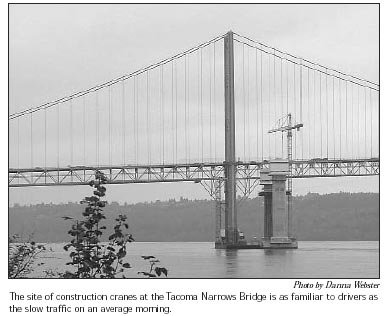All of those who live on the peninsula have something in common, and no, it isn’t our common desire to remain caffeinated. It’s the daily or weekly need to confront the Tacoma Narrows Bridge, AKA Galloping Gertie, or what I call the Iron Monster.
 Driving can be dangerous no matter where you go. More than 43,000 Americans lost their lives on the nation’s highways last year. But there is something especially intimidating about venturing out onto the Narrows Bridge, which as the name would suggest, is damned narrow. And not just narrow, but potentially lethal, mainly because there isn’t any divider down the middle. Between Jan. 1, 1993 and Dec. 31, 2003 there were 565 accidents on the bridge involving some 1,187 vehicles, according to Washington State Patrol data. Some 255 of those involved injuries — and eight of them resulted in fatalities.
Driving can be dangerous no matter where you go. More than 43,000 Americans lost their lives on the nation’s highways last year. But there is something especially intimidating about venturing out onto the Narrows Bridge, which as the name would suggest, is damned narrow. And not just narrow, but potentially lethal, mainly because there isn’t any divider down the middle. Between Jan. 1, 1993 and Dec. 31, 2003 there were 565 accidents on the bridge involving some 1,187 vehicles, according to Washington State Patrol data. Some 255 of those involved injuries — and eight of them resulted in fatalities.
Now maybe you’re one of the brave souls who likes to drive in the fast lane, just daring west- or eastbound vehicles to cross over the centerline and collide with you at a combined speed of a hundred miles-per-hour, but not me. Even though I tend to be impatient with people who drive under the limit, I not only forgive them out on the Iron Monster, I pull over into the right-hand lane and join them!
From the eastbound perspective, I can see the bridge towers that will support the New Tacoma Narrows Bridge when it opens in the spring of 2007. Assuming that the project remains on schedule, the work to retrofit the existing bridge will be completed in 2008. The new structure will carry eastbound traffic —and the old bridge will handle westbound traffic. Given the fact that volume is expected to grow from the roughly 90,000 vehicles that use the State Route 16 corridor today, to approximately 120,000 vehicles per day in the year 2020, we certainly need the extra capacity.
For those of you who like stats, add these factoids to your collection: The towers that can now be seen on the south side of the old bridge will be 510 feet tall when they are completed and each one of them will consume 8,000 yards of concrete. Oh, and should they need to, engineers can add a second deck to the new bridge at some future date. The possibility of light rail has been mentioned. The new bridge deck will be 5,400 feet long, carry three 12-foot-wide traffic lanes, two 10-foot shoulders, and a 10-foot bicycle/pedestrian path that will be separated from traffic by a barrier. A very good idea indeed!
And that brings me back to the issue of safety…. The overall project is slated to cost $849 million, $800 million of which will be paid for with tolls. It will cost us $3 per trip for starters, but the Washington State Transportation Commission can increase that, and according to those in the know they probably will. Based on the $3 rate and existing assumptions, it will take 23 years to pay for the new bridge. That’s a long time, but one-way traffic will make safer to cross the bridge, and will ultimately save lives.
That’s the good news… The bad news that 76 million baby boomers (people born between 1946 and 1964) will be elderly by then! That’s 29 percent of the current population. And, since we boomers love our cars, we’ll be driving. So the rest of you young whippersnappers can expect to see us out on the bridge deck, listening to the Beach Boys, and motoring across that 23-year-old bridge at about 30 miles-per-hour. You might want to allow a little extra time.
If you would like to learn more about the existing bridge, go online to:www.wsdot.wa.gov/TNBhistory/Machine/machine5.htm#2.
Or, if you would like to track the progress of the new bridge, visitwww.wsdot.wa.gov/projects/sr16narrowsbridge.
UNDERWRITTEN BY THE FUND FOR NONPROFIT NEWS (NEWSMATCH) AT THE MIAMI FOUNDATION, THE ANGEL GUILD, ADVERTISERS, DONORS AND PEOPLE WHO SUPPORT INDEPENDENT, NONPROFIT LOCAL NEWS